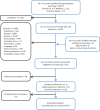Comparison of the Non-VKA Oral Anticoagulants Apixaban, Dabigatran, and Rivaroxaban in the Extended Treatment and Prevention of Venous Thromboembolism: Systematic Review and Network Meta-Analysis
- PMID: 27487187
- PMCID: PMC4972314
- DOI: 10.1371/journal.pone.0160064
Comparison of the Non-VKA Oral Anticoagulants Apixaban, Dabigatran, and Rivaroxaban in the Extended Treatment and Prevention of Venous Thromboembolism: Systematic Review and Network Meta-Analysis
Erratum in
-
Correction: Comparison of the Non-VKA Oral Anticoagulants Apixaban, Dabigatran, and Rivaroxaban in the Extended Treatment and Prevention of Venous Thromboembolism: Systematic Review and Network Meta-Analysis.PLoS One. 2016 Sep 15;11(9):e0163386. doi: 10.1371/journal.pone.0163386. eCollection 2016. PLoS One. 2016. PMID: 27631606 Free PMC article.
Abstract
Background: Historically, warfarin or aspirin have been the recommended therapeutic options for the extended treatment (>3 months) of VTE. Data from Phase III randomised controlled trials (RCTs) are now available for non-VKA oral anticoagulants (NOACs) in this indication. The current systematic review and network meta-analysis (NMA) were conducted to compare the efficacy and safety of anticoagulants for the extended treatment of VTE.
Methods: Electronic databases (accessed July 2014 and updated April 2016) were systematically searched to identify RCTs evaluating apixaban, aspirin, dabigatran, edoxaban, rivaroxaban, and warfarin for the extended treatment of VTE. Eligible studies included adults with an objectively confirmed deep vein thrombosis, pulmonary embolism or both. A fixed-effect Bayesian NMA was conducted, and results were presented as relative risks (RRs). Sensitivity analyses examining (i) the dataset employed according to the time frame for outcome assessment (ii) the model used for the NMA were conducted.
Results: Eleven Phase III RCTs (examining apixaban, aspirin, dabigatran, rivaroxaban, warfarin and placebo) were included. The risk of the composite efficacy outcome (VTE and VTE-related death) was statistically significantly lower with the NOACs and warfarin INR 2.0-3.0 compared with aspirin, with no significant differences between the NOACs. Treatment with apixaban (RR 0.23, 95% CrI 0.10, 0.55) or dabigatran (RR 0.55, 95% Crl 0.43, 0.71) was associated with a statistically significantly reduced risk of 'major or clinically relevant non-major bleed' compared with warfarin INR 2.0-3.0. Apixaban also showed a significantly reduced risk compared with dabigatran (RR 0.42, 95% Crl 0.18, 0.97) and rivaroxaban (RR 0.23, 95% Crl 0.09, 0.59). Sensitivity analyses indicate that results were dependent on the dataset, but not on the type of NMA model employed.
Conclusions: Results from the NMA indicate that NOACs are an effective treatment for prevention of VTE or VTE-related death) in the extended treatment setting. However, bleeding risk differs between potential treatments, with apixaban reporting the most favourable profile compared with other NOACs, warfarin INR 2.0-3.0, and aspirin.
Conflict of interest statement
Figures


References
-
- Cohen AT, Agnelli G, Anderson FA, Arcelus JI, Bergqvist D, Brecht JG, et al. Venous thromboembolism (VTE) in Europe. The number of VTE events and associated morbidity and mortality. Thromb Haemost. 2007;98(4):756–64. . - PubMed
Publication types
MeSH terms
Substances
LinkOut - more resources
Full Text Sources
Other Literature Sources
Medical
Miscellaneous

